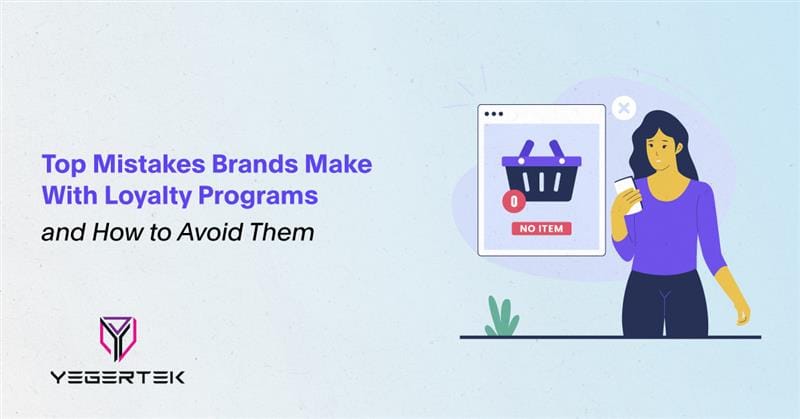
When executed correctly, customer loyalty programs can be a game-changer for your brand, helping you build lasting relationships, boost repeat purchases, and drive lifetime value. But just because they are so popular today and you see them everywhere, doesn’t mean all of them are equally effective. Just think about it for a second, how many loyalty programs did you sign up for and forget within days? For most brands, the real struggle isn’t in launching a loyalty initiative, it’s making one that customers actually care about.
In this blog, we will try to look at the top 10 mistakes that brands make with loyalty programs and how you can avoid falling into the same traps. So if you are designing a new customer loyalty program for your brand, this blog could be your cheat sheet to getting it right on the first go.
#1 Making Everything Too Complicated
More isn’t always better. Especially in the case of customer loyalty programs, where customers look for an easy and quick redemption process. Brands often try to pack a lot into their loyalty solutions, thinking that more features might mean more engagement. But on the contrary, complicated features and hard-to-redeem rewards often lead to dissatisfaction among customers, making them lose interest fast.
If the redemption process is too long, if the customers don’t have enough visibility on points balance, or if the interface is too slow for the customers to understand the rewards they have earned, they won’t make it over the line and might even abandon their cart.
In one of the reports published by Statista, it was noted that on a global scale, only about 49% of the total rewards are redeemed. Making it over this line requires clear communication, better personalisation, adequate rewards, and an easy redemption process. So keep things simple. Whether it is a point-based reward that you are offering or tiered rewards, make sure the rules are easy to follow and communication is top-notch.
#2 Lack of Personalisations
Sending your customers blanket emails and generic rewards that don’t take individual preferences into account may have worked a decade ago, but in today’s world full of tailored content and curated shopping experiences, offering the same loyalty to everyone just doesn’t cut it anymore.
When you tap into your customer’s preferences and values, you get a chance to unlock deeper insights into their shopping habits and the kind of rewards that would persuade them to make repeated purchases.
#3 Irrelevant Rewards
Another major mistake that many brands make is offering generic or uninspiring incentives that don’t align with their audience’s needs. Not all customers are the same, and not all rewards are created equal. For example, you may be offering a pink lipstick for free on the purchase of certain makeup products, but not every customer may use a pink lipstick. A free product that no one wants or a discount that feels like a gimmick can cheapen the customer experience.
So instead of offering generic freebies, focus on rewards that resonate with your customers. Use customer data and purchase behavior to tailor incentives that feel personal and valuable. This brings us to the next common mistake that businesses make while building customer reward programs.
#4 Rewarding Only Purchases
While it is a widely understood fact that loyalty programs must always result in increased revenue and enhanced ROI, rewarding only purchases and ignoring other effective metrics may not be effective in the long run. Long term loyalty relies on a combination of purchases, referrals, app downloads, reviews, social follows, and customer activities that the brand wants the customers to do.
When you reward your customers for these activities along with purchases, you build value based loyalty and a loyal community for your brand that is very likely to stand by your business through thick and thin. By rewarding different types of customer activities, such as app downloads, referrals, social follows, etc., you get to level up your business strategy and stay one step ahead of your competitors.
#5 Not Selecting the Right Loyalty Program
It could be challenging for businesses to select the right type of loyalty program, especially when there are so many options to choose from. Since not every type of reward program would fit your business model, selecting the right one depends a lot on understanding your business model and your customers’ shopping habits.
We at Yegertek offer a plethora of reward programs to choose from. You could select any one of our loyalty programs from the list below –
- Tiered Loyalty
- Paid Loyalty
- Gamification
- Perks Loyalty
- Hybrid Loyalty
- Lifestyle Loyalty
- Coalition Loyalty
- Standard Loyalty
- Influencer Loyalty
- Loyalty Communities
(Also Read: How Small Businesses Can Build Effective Loyalty Programs on a Budget )
#6 Not Taking Emotional Connection into Account
Don’t make your loyalty program all about perks and points. Always take into account the emotional value that the customers derive from your loyalty programs, as customer loyalty isn’t always transactional. It is vital to make your customers feel appreciated from time to time for their loyalty and repeat purchases, as this way they feel more aligned with your brand and are more likely to stay loyal even when the competitors offer heavy discounts.
So, as a thumb rule, while you offer shiny and attractive transactional rewards to your customers, also make sure you are celebrating their milestones, showing gratitude, and supporting causes that they care about. Ultimately, the goal of customer loyalty programs is to build a relationship with your clients and not just drive sales.
#7 Not Promoting the Program Enough
Make sure your loyalty offering is visible and compelling. You may have an amazing loyalty program, but if no one knows about it, what’s the point? Not promoting the reward program enough is one of the major reasons why most programs fail. Highlight it on your website, push it in emails, showcase it on social media, and train staff to talk about it in-store.
Visibility drives enrollment, and that in turn drives engagement, so make sure your offerings are accessible, with a clear onboarding process that welcomes new members.
#8 Programs Not Aligning with Brand Identity
Whether you are a luxury brand or a modern brand with quirky products, it is important that your reward programs carry the same voice as everything else you do. A lot of the time, businesses fail to align their loyalty solutions with their brand identity, and suddenly, the reward program feels out of place. Your loyalty program should feel like a natural extension of your brand. If the design, tone, or rewards feel disconnected from your overall identity, it creates confusion and weakens your message.
Therefore, make sure your loyalty experience reflects your brand values and aesthetic.
#9 Ignoring Customer Feedback
Even when you are doing everything right, taking customer feedback into account is the most important step in the success or failure of your loyalty program. If you are not actively listening to what your customers are saying about your program, you will miss out on opportunities to improve it.
Therefore, as a rule of thumb, make sure to use surveys, reviews, and even social media to understand what your members love, what frustrates them, and what they would like to see. A lot of brands do this, but even then fail to act on the feedback. Loyalty is a two way street, so when customers see you responding to their needs, it deepens their trust in your brand.
(Related: Customer satisfaction and loyalty: Is there a difference?)
#10 Not Leveraging Technology to Its Fullest
Mobile apps, digital wallets, and push notifications aren’t just nice-to-haves anymore. They are a crucial part of the overall tech stack that helps in delivering efficient rewards to your customers and increasing engagement. If your loyalty program isn’t mobile-friendly, you will miss out on a huge chunk of engagement.
So, make sure it is easy for your customers to redeem rewards, check status, and interact with your brand through their mobile devices. A mobile-first experience is not only convenient but also boosts retention by keeping your program top of mind.
Wrapping It Up
Creating a successful loyalty program requires deep thought, strategy, and a thorough understanding of what your customers value. It isn’t just a transactional process, and more importantly, a value driven engagement that fosters true and lasting loyalty.
Building a loyalty program based on what your competitors are doing without a thoughtful investigation of your customers’ needs is bound to fail. The key is to keep it personal, simple, visible, and evolving, so that you can build a community of engaged, repeat customers who stick around for the long haul. After all, it isn’t just about checking the boxes, it is about driving actual value for your customers and for your business.



